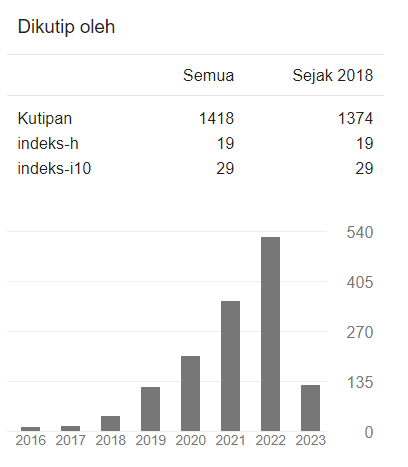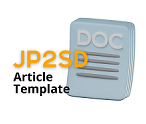PENGEMBANGAN BAHAN AJAR MEMBACA PERMULAAN DALAM PEMBELAJARAN TEMATIK DENGAN MODEL VARK (VISUAL, AUDITORY, READ/WRITE AND KINESTHETIC) DI KELAS I SEKOLAH DASAR
DOI:
https://doi.org/10.22219/jp2sd.v7i2.8879Keywords:
Teaching Materials, Reading Beginning, Vark ModelAbstract
This study aims to produce the process of developing teaching reading materials and produce teaching reading materials with Vark (Visual, Auditory, Read / write, and Kinesthetic) models for class 1 valid and practical educators and students. The development is based on the Plomp model (Preliminary Research, Prototyping Phase and Assessment Stage) which emphasizes the context of needs (educators and students) so that the initial reading skills learning material is produced based on the Vark model. Based on the results of the Kevalitan trial, it can be seen from the validation of content, language, presentation, graphics and lesson plans, overall 93.10% with valid valid categories. Praticality of teaching materials is seen from the educator's response, 98.92% of the students' responses are 96.15% while the effectiveness of Reading is a percentage of 100%. It can be concluded that the preliminary reading material using the Vark model that was developed is suitable for use in reading the beginning with the Vark model in grade 1 elementary school.Downloads
References
Aay. 2016. Upaya Meningkatkan Kemampuan Membaca Permulaan Melalui Metode Montessori Pada Siswa Kelas I Di Sdn Rawamangun 09 Pagi Jakarta Timur, (1), 70–110.
Chandra, Mayarnimar, M. H. 2018. Keterampilan Membaca Dan Menulis Permulaan Menggunakan Model Vark Untuk Siswa Sekolah Dasar, 2, 72–80
Fadilah .2014. Implementasi Kurikulum 2013 Dalam Pemebelajaran SD/MI, SMP/MTs dan SMA/MA. Yogyakarta: Ar-Ruzz Media.
Faisal. 2014. Sukses Mengawali Kurikulum 2013 di SD (Teori & Aplikasi). Yogyakarta: Diandra Creative.
Fleming, N. D. 2001. Teaching and Learning Styles: VARK Strategies. New Zealand: Christchurch, N.Z. & N.D. Fleming
Fleming, Neil & Baume, David. 2006. Learning Style Again: VARKing Up The Right Tree!.Jurnal Akademik vol 11, No.137. New Zeeland
Mayarnimar, Taufina. 2017. Validity Analysis Of The Vark (Visual , Auditory , Read- Write , And Kinesthetic) Model – Based Basic Reading And Writing Instructional Materials For The 1st Grade Students Of Elementary School, 118, 870–874. (http://creativecommons.org/licenses/by-nc/4.0/)
Mohammadi, S., Mobarhan, M. G., & Mohammadi, M. 2015. Age And Gender As Determinants Of Learning Style Among Medical Students, 7(4), 292–298. Https://Doi.Org/10.9734/BJMMR/2015/15741
Muhammadi, Taufina, dan C. (n.d.). 2018. Literasi Membaca Untuk Memantapkan Nilai Sosial Siswa Sd, volume 17. Nomor 2
Othman, N., & Hasril, M. 2010. Different Perspectives of Learning Styles from VARK Model, 7(2), 652–660. journal .sciencedirect.com. https://doi.org/10.1016/j.sbspro.2010.10.088
Rachmawaty, M. 2017. Penigkatan Kemampuan Membaca Permulaan Melalui Dinding Kata (Word Wall), (1), 28–44. Jurnal Ilmiah Pendidikan Prasekolah Dan Sekolah Awal. Http://Journal.Umpo.Ac.Id/Index.Php/Indria/IndexRusman. 2014. Model-model Pembelajaran Mengembangkan Profesional Guru. Jakarta: Rajawali Pers
Sari, M. P. 2017. Pengembangan buku ajar subtema aku bangga dengan daerah tempat tinggalku melalui strategi pq4r dengan pembelajaran langsung di kelas iv sd, 1(1), 1–20.
Tarigan, Henry Guntur, 2008a. Menyimak Sebagai Suatu Keterampilan Berbahasa. Bandung: AngkasaPrastowo, Andi. 2013. Pengembangan BahanAjar Tematik terpadu. Jogjakarta: Diva Press.
Downloads
Published
Issue
Section
License
Authors who publish with Jurnal Pemikiran dan Pengembangan Sekolah Dasar (JP2SD) agree to the following terms:
- For all articles published in Jurnal Pemikiran dan Pengembangan Sekolah Dasar (JP2SD), copyright is retained by the authors. Authors give permission to the publisher to announce the work with conditions. When the manuscript is accepted for publication, the authors agree to automatic transfer of the publishing right to the publisher.
- Authors retain copyright and grant the journal right of first publication with the work simultaneously licensed under a Creative Commons Attribution-ShareAlike 4.0 International License that allows others to share the work with an acknowledgment of the work's authorship and initial publication in this journal.
- Authors are able to enter into separate, additional contractual arrangements for the non-exclusive distribution of the journal's published version of the work (e.g., post it to an institutional repository or publish it in a book), with an acknowledgment of its initial publication in this journal.
- Authors are permitted and encouraged to post their work online (e.g., in institutional repositories or on their website) prior to and during the submission process, as it can lead to productive exchanges, as well as earlier and greater citation of published work (See The Effect of Open Access).

This work is licensed under a Creative Commons Attribution-ShareAlike 4.0 International License.


















